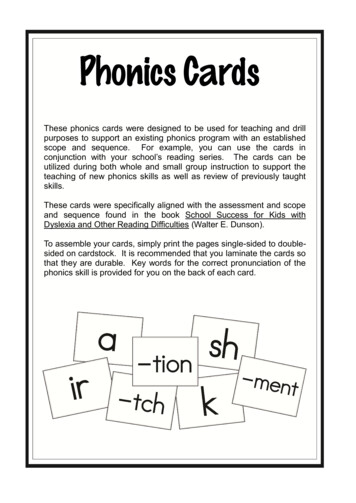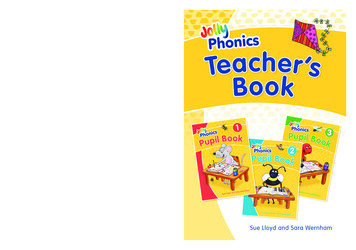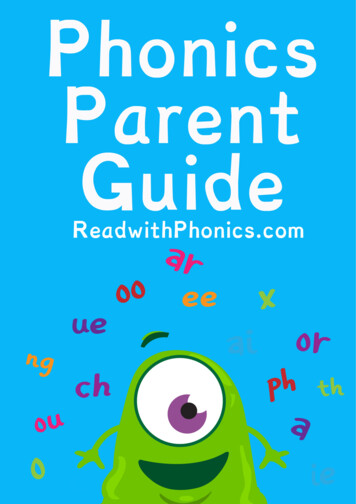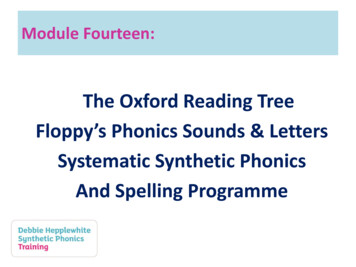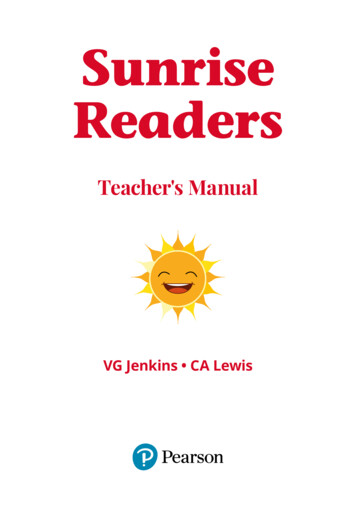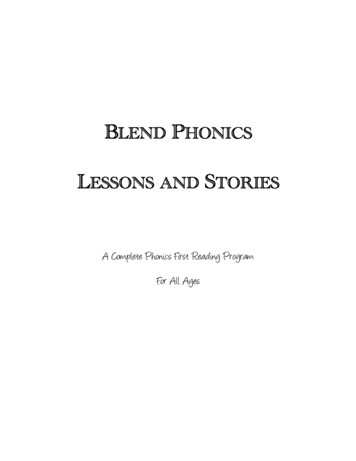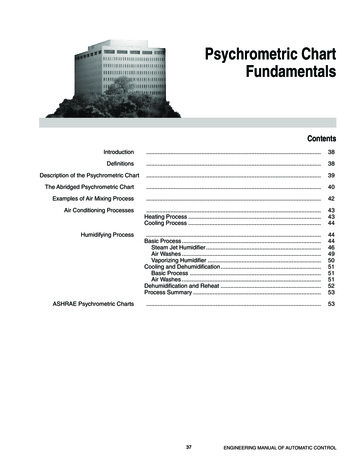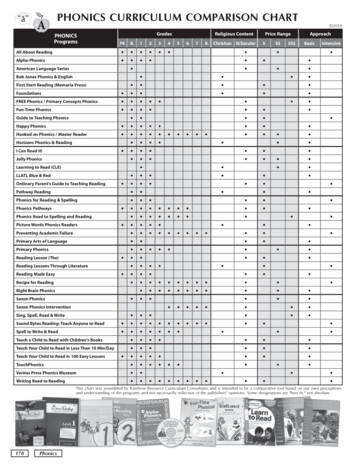
Transcription
PHONICS CURRICULUM COMPARISON CHARTPHONICSProgramsAll About ReadingAlpha-PhonicsAmerican Language SeriesBob Jones Phonics & EnglishFirst Start Reading (Memoria Press)FoundationsFREE Phonics / Primary Concepts PhonicsFun-Time PhonicsGuide to Teaching PhonicsHappy PhonicsHooked on Phonics / Master ReaderHorizons Phonics & ReadingI Can Read It!Jolly PhonicsLearning to Read (CLE)LLATL Blue & RedOrdinary Parent's Guide to Teaching ReadingPathway ReadingPhonics for Reading & SpellingPhonics PathwaysPhonics Road to Spelling and ReadingPicture Words Phonics ReadersPreventing Academic FailurePrimary Arts of LanguagePrimary PhonicsReading Lesson (The)Reading Lessons Through LiteratureReading Made EasyRecipe for ReadingRight Brain PhonicsSaxon PhonicsSaxon Phonics InterventionSing, Spell, Read & WriteSound Bytes Reading: Teach Anyone to ReadSpell to Write & ReadTeach a Child to Read with Children's BooksTeach Your Child to Read in Less Than 10 Min/DayTeach Your Child to Read in 100 Easy LessonsTouchPhonicsVeritas Press Phonics MuseumWriting Road to ReadingGradesPKK1 234Religious Content5678Christian N/Secular Price Range 2018ApproachBasic Intensive This chart was assembled by Rainbow Resource Curriculum Consultants and is intended to be a comparative tool based on our own perceptionsand understanding of the programs and not necessarily reflective of the publishers' opinions. Some designations are "best fit," not absolute.178Phonics
2018Skills CoveredSpelling G.U.M. Reading ComponentsHandwriting KitsWkbksReadersTM Notes Manipulatives Audio DVDs Teacher Manual (TM) is PDF. Has an app; downloadable TM & worksheets.Orton Gillingham; needs flashcards. Coordinates with Explode the Code. Manipulatives in K. Multi-sensory. Flashcards. Activity sheets rather than workbooks. Hands-on. Supplemental Read Aloud library.Multi-sensory. Also ELL/ESL appropriate.Phono-Graphix system. For struggling readers. Phonogram cards. Readers & Teacher Manual (TM) are PDF. Uses AAS.Supplements available from publisher.Incorporates Elson Readers. Multi-sensory. Some components on CD-ROM.For struggling readers.Flashcards. For struggling readers. Flashcards. For struggling readers.Teacher Manual (TM) in K-1st only.Also ELL/ESL appropriate. Phonogram cards. Lots of add ons.Readers of your choice. Hands-on. Adds art appreciation and projects.Spalding method.This chart was assembled by Rainbow Resource Curriculum Consultants and is intended to be a comparative tool based on our own perceptions andunderstanding of the programs and not necessarily reflective of the publishers' opinions. Some designations are "best fit," not absolute.Phonics179
PHONICSCOMPLETE PROGRAMSPrograms in this section go beyond teachingchildren how to read, incorporating phoneticreaders, spelling, and writing as well.Arranged roughly by grade.JOLLY PHONICS (PK-1 )Kids will have a jolly good time learning toread with this well-conceived program whichoriginated in Great Britain. Used successfullywith students as young as three, the methods andresults achieved are impressive. The author ofthe program has identified five basic skills needed for reading: Learning the letter sounds Learning letter formation Blending - for reading Identifying the Sounds in Words Tricky Words - irregular wordsThese are the skills taught, in tandem, throughout the program. Teaching is straight-forward,but fun. Children learn via visual, auditory,and tactile-kinesthetic modes – for instance,sky-writing and finger-tracing of letters. Lettersare introduced in a seven-step order (non-alphabetical) that allows immediate decoding of manywords. #1 – s, a, t, i, p, n; #2 – c/k, e, h, r, m,d; #3 – g, o, u, l, f, b; #4 – ai, j, oa, ie, ee, or;#5 – z, w, ng, v, oo (two sounds); #6 – y, x, ch,sh, th (two sounds); and #7 – qu, ou, oi, ue, er,ar. Entertaining videos introduce letter soundsand a movement for each letter “hooked” to amemorable story.All program components are high quality andbrightly colorful (activity books are black andwhite to allow for coloring), well designed andeasy to use. The “program” can be used with aminimum of the Phonics Handbook or by utilizing some of or all the following components;each of which supplies a level of presentation,review, and reinforcement.You might want to begin the program by viewing the Jolly Phonics DVD. If you have nevertaught a child to read, this will boost your confidence, as you watch various under-fives learningto read fluently and writing in full sentences.The DVD covers all 42 letter sounds through theadventures of Inky Mouse, Snake, and Bee. Thereis a spoken guide to all the letter sounds as wellas a fun activity for each sound/story. Includedis a one hour video – “Using Jolly Phonics” –which does a great job of conveying the philosophy, approach, and teaching methods employedin the program.The Phonics Handbook, available in eitherprint or pre-cursive version, provides a year’sworth of detailed lesson plans that show youhow to introduce the five skills and what formthe implementation will take. Carefully thoughtout, it progresses systematically - introducingthen honing each skill. Instructions for eachpresentation are detailed yet simple, straightforward and sensible. The bulk of the PhonicsHandbook is all the reproducible material youwill use in the program - Sound Sheets, FlashCard Sheets, Sound Book Sheets (children createa sound book as they go), Word Box Sheets (tomake your own practice word boxes), StringJoining Sheets (you’ll probably want to reproduce on cardstock if using string OR use as180Phonicsmatching sheets), Matching Letters, Words andPictures cards, Sentence Sticking (really funexercises), Letter Clue Pictures (practice wordfamilies), Reading Games, Missing Sound Sheets,Homework Writing Sheets and Tricky WordSheets. The last reproducible section providessheets practicing Alternative Spellings of Vowels.After all of the clusters are introduced, childrenwill learn alternate ways to write some of thesounds. For example, the ‘ai’ sound is introduced in set 4 as one of the phonemes. Duringthe last week, children learn two alternate (‘a e’and ‘ay’) ways to say ‘ai’. 218 pgs.Finger Phonics Books are beefy board bookscorresponding to the seven step order. Each hasprint letter cut-outs that allow for finger-tracing a satisfying tactile experience. A dot shows theorigin point and arrows direct the flow - preparing your child for writing.Jolly Songs is a collection of songs set to popular tunes for each of the 42 letter sounds. This setincludes a CD and a print letter book. In additionto the songs sung by children in British Englishthe CD also includes a spoken guide to all 42letter sounds and alternative vowels. The 24-pagebook includes games and activities.Jolly Stories Board Book covers all 42 lettersounds and follows Inky Mouse and friendsthrough seven illustrated stories. A large letter(print letters) is embossed on the story spread fortactile recognition. Tips and advice for parentsare included. 80 pgs.Phonics Workbooks put newly acquired skillsinto practice with letter stroke and print letterpractice. There is a 2-page spread (black andwhite) for each phoneme that recaps the story,motion, provides additional writing exercise(tracing the target letter) and introduces theupper-case symbol. Each 24-page workbook(seven in all - one for each group of letters) alsoincludes a variety of recap activities at the end.Activity Books (one for each set of letters) arecolorful and provide sound sheets that coordinatewith the story, providing a picture to color, areminder of the action associated with the sound,lower-case letters to trace, and several words thatbegin with the sound. Two pages of stickers arealso included, along with instructions. 36 pgs.The Letter Sound Poster is a single sheet (23”x 33”) with the 42 letter sounds (print version)arranged in their groups. Illustrations prompt theJolly Phonics action and sound.Student Books each feature all 42 letter soundsand are used for reinforcement and further skilldevelopment. They cover letter formation, listeningfor letter sounds in words, blending activities, andtricky words. The books build on each other; eachintroducing more tricky words as well as soundspellings and spelling patterns and even basic sentence structure. The Teacher Book accompaniesthese books and provides detailed lesson plans foreach page of the Student Books. Student books –48 pgs; Teacher’s book – 184 pgs.The Games CD is great for independent workand reinforcement. There are twenty activitieswith Inky Mouse and friends; three levels of play– easy, medium, or hard – with the choice ofprint or pre-cursive letter options during installation. The single user license CD is both PC andMac compatible.The Word Book is a reference book for teachingreading and writing skills such as blending spelling and dictation. It has lists of words made fromthe 42 phonemes, tricky words and words withconsonant blends. 48 pgsThe Jolly Dictionary uses print letters andteaches students how to look up and understandwords. A pronunciation guides is given foreach of 6,000 words. Easy to read definitionsand age-appropriate words make this a usefulresource for young students. 340 pgs.There are several apps for smartphones and tablets available at the Apple App Store or GooglePlay – Jolly Phonics Letter Sounds, Jolly PhonicsLessons, Jolly Songs and an app for teachers. Someare free and some require a small fee.In summary, this would be an excellent programto begin with a K4 or K5 student that, in a relatively short time, would leave them reading (andwriting) at about a 1.5 grade-level. It goes muchdeeper than most beginning phonics programs,though stops a little short of a K-2 program likeSing, Spell, Read and Write. Follow up with aphonetic reading and/or spelling program to coverthe remaining phonograms. It’s a good value forthe materials and quality of instruction, is fun andeffective, and gets them off to a great start.029240 Phonics Handbook . . 42.5033.50066999 Phonics Handbook (Precursive). . . . . . . . . . . . . . . . 42.5039.95029227 DVD . . . . . . . . . . . . 37.5034.95029243 Phonics Word Book . . .4.25029223 Finger Phonics (set/7) 66.5051.95027180 Songs Book & CD . . . 17.5016.95027183 Stories Board Book . . 29.5027.50029231 Phonics Wkbks (set/7) 22.7518.50027136 Activity Books 1-7 . . 45.5035.95027141 Games CD . . . . . . . . 59.9555.95027142 Letter Sound Poster . . .5.95066995 Student Book 1 . . . . . .4.50066996 Student Book 2 . . . . . .4.50066997 Student Book 3 . . . . . .4.50066998 Teacher’s Book . . . . . 12.9512.75035779 Dictionary . . . . . . . . 13.5010.95VERITAS PHONICSVeritas Press Phonics Museum (K-1)Of all the multi-sensory programs we carry,this one is by far the most weighty - and I domean in pounds! On a by-the-pound basis, youget the most for your money here! Retailing forless than the Sing, Spell, Read and Write ComboKit, this program will definitely appeal to parentsusing the Classical approach, parents who wantsolid, moral readers (by Christian authors) withhistorical and biblical content, and parents wholove the idea of incorporating art appreciationinto their phonics program.See page vi for key to Consumer Product Safety Improvement Act warning labels.
The museum theme is a wonderful concept thatis carried throughout the program, beginningwith The Alphabet Quest, a story about a boyand a knight (actually a suit of armor) who findobjects beginning with each letter of the alphabeton a trip through a museum. At the K level, asyou progress through each letter sound, studentswill “hang” a painting showing this object in theirown museum. The flashcards, likewise, havereproductions of all the pictures referred to inThe Alphabet Quest. Illustrations throughout theworkbooks and playing cards have an “antique”look as well - in keeping with the museumtheme.There’s a lot to like in this program. First, it verythoroughly covers the phonetic constructs fromletter sounds to silent consonants and everythingin between. Secondly, I love the student workbooks. This is the first phonics course I’ve seenin which the student books are actually thickerthan the teacher manuals! They are chock fullof useful, well-conceived activities to teachphonics skills. I appreciate that handwriting(D’Nealian-style) is included and instructionsfor forming each letter and for writing in generalare in the teacher’s manual. Instead of havingchildren form letters from a model or dottedline, “hollow” letters are supplied and childrenwrite within them. This is a sensible approach.It gives young children boundaries until goodwriting habits are formed. Another good ideahere is the introduction of both printed and written forms of the letters right from the beginning.Then, the 31 Primers. These are real books,many about real people, places and events, notjust slapped together for phonics practice. Theeight Kindergarten Primers, for example, arestories about Pan (Greek god), St. Patrick, thePilgrims’ trip on the Mayflower, Pepin the Short,the Oregon Trail, Greek mosaics, Ben Franklin,Daniel in the Lion’s Den, Axum (the historickingdom in northeastern Ethiopia), and the CivilWar. These books are quality constructions withnice, glossy covers and colorful illustrations withoriginal art done by a variety of artists using avariety of media. In fact, all of the componentsof the program are impressive in quality.Another facet of the program I think parents willappreciate is the incorporation of real art activitiesfor students to complete, correlated to the instruction. In Level K students make apple prints whenlearning the letter “A,” construct a monster maskfor “M,” make butter for “B”, and so on. In FirstGrade many art activities are based on the storiesfrom the Primers. As in the K level, these usedifferent methods and media. Reading comprehension exercises are also welcomed into the mixof student sheets in First Grade.Teaching instructions for the program are verycomplete and easy to follow, but not scripted(Yea!). Minimal preparation time is required.Daily lessons tell you just what to do when andhow, correlating worksheet exercises, games,and other activities to the skills. Workbookinstructions are here as well, along with thereduced student page, so you don’t have tojuggle two books when preparing. It wouldbe helpful to read through each lesson beforeteaching. No time estimate is given, but withall the worksheets, art projects and activities, Iwould expect each lesson to last about an hour.Two games (with variations) are also includedand used by both levels of the program. At theK level they practice letter sounds and letterrecognition. In first grade they practice blends,long vowel words, sight words and phonograms.Unique puzzle pieces are also supplied and usedto construct sound combinations and words.I guess the only component of the programthat I’m not personally thrilled with is the musicCD. The vocal and production quality is great,but they strike me as more entertaining thaninstructive. I was a little surprised at the rock ‘nroll and contemporary beats here - being froma publisher of Classical materials. The tunesare catchy, even zippy, and include a variety ofstyles. However, the lyrics, speed and musicalcomposition of the songs would make it difficultfor children to sing along. It’s confusing to methat “wr” is treated as a blend in the blends songand in the program, but also covered with thesilent consonants. I thought a blend was a blendof two sounds. It’s difficult to make out thelyrics to the Ing Ang Song (sung as an Al Jolsenlike vocal), though the lyrics are included in theback of the Teacher Manual. While I grant thatthis CD is more entertaining to listen to than yourstandard phonics fare, I would have preferredsomething with less vocal range, more repetition,and blander music that was easier to imitate andlearn from. Sometimes, simpler is better. Bobthought the music reminded him of somethingfrom Sesame Street, that would be heard as various letters or visuals popped and jumped acrossthe screen - only sans visuals. But the music CDhere is more an ancillary to the program - it’s notused as a core instructional tool in the way thesongs are in Sing, Spell, Read and Write. So thisis not a major consideration if you’re consideringthe program.My only other quibble is minor, also. In the Klevel, a third sound of “a” is introduced as “ah”as in father. But, included in the instruction arewords like call, ball, fall, etc. I would have trouble pronouncing call as “cahl” rather than “cawl.”Then, in First Grade, you ask children whatsound is made by “a” in “All,” “Call,” “Fall,” and“Wall.” After the student responds with the “Ah”sound, you proceed to explain that, when “ah”is followed by “L,” both sounds change a littleand together make the sound of “aw.” Then you“affirm that this is a completely new sound.” If Iwere using the program, I would omit the initial,less-than-correct teaching at the K level.And I would most definitely use the program. Infact, if I were Siskel and Ebert, I would give thisprogram two thumbs up!The Combo Kit contains everything you needfor Grades K and 1. Included in the hefty ComboKit are: The Alphabet Quest (book), 31 Primers,Kindergarten Teacher Manual, KindergartenWorkbook, First Grade Teacher Manual, FirstGrade Workbook, 1 Deck of KindergartenArchives Game Cards, 1 Deck of First GradeArchives Game Cards, 2 Decks of Playing Cards(alphabet), 2 Decks of Playing Cards (digraphs),46 5”x8” Flashcards, 1 Pop-Up Museum/GameBoard, 1 Music CD, 1 Packet of Game Pieces,1 Deck of Fine Art Cards, 1 Paper Doll Sheet, 1Paper Clip Packet, 1 Iron-on Museum Bag Decal.The Kindergarten and Grade 1 kits containeverything needed for that specific grade. TheKindergarten Kit includes all of the componentsfrom the Combo kit except the Teacher Manual,Workbook, and Primers for Grade 1, and the FirstGrade Game Cards. Likewise, the First GradeSee page vi for key to Consumer Product Safety Improvement Act warning labels.Kit likewise includes all of the components fromthe Combo Kit, except the Teacher’s Manual,Workbook, and Primers for Grade K, and theKindergarten Game Cards. Additional studentsets are available with and without primers.016187 Combo Kit . . . . . . . . . .99.00016191 Kindergarten Kit . . . . . .149.00016192 K Student Kit with Primers49.00016193 K Student Kit w/o Primers25.00016190 Grade 1 Kit . . . . . . . . .149.00016188 Grade 1 Stdnt Kit w/Primer69.00016189 Grade 1 Stdnt Kit w/oPrimer 25.00SAXON PHONICS (K-2)If you are already acquainted with Saxon’selementary math program, it will be easy for youto visualize Saxon Phonics. It is very much thesame in format and in the intense, systematic,and incremental approach employed. Anothersimilarity - and one that will be much appreciated by the novice - is the ability for a teacher withabsolutely no previous experience in teachingthe subject to be successful with the program.It certainly wins my vote for “easiest to teach.”Every lesson is scripted - telling you just what tosay when. Lessons are totally laid out for you,following the same review, incremental learning,and reinforcement approach that makes SaxonMath so effective. Any materials needed areclearly listed. Even if you’ve never opened abook on how to teach reading and have neverheard the word “phonogram” before, you will becomfortable using Saxon Phonics.The curriculum provides integrated reading,spelling, and writing instruction for each gradeK through 2. The Home Study Kits containeverything you need (except for some aroundthe-home objects used primarily to illustrateletter sounds). Each grade level kit includes aTeacher Manual, Teaching Tools, and StudentMaterials packet. The Teacher Manual containsa program overview, teaching instructions, chartsand pronunciation guides summarizing instruction covered in that level, a lesson-by-lesson listof all materials needed, reading word lists, anddetailed directions for games and activities (manyuse the card decks provided with the program).140 scripted lessons each provide a thoroughreview of previously-learned material and introduction of new skills. Prior to actual instructionis a shaded box containing a list of materialsneeded for the lesson, and any pre-class preparation. Daily lesson elements vary (not every lesson has all of the components mentioned below),but provide a good mix of activities appealing toall learning modalities (multisensory). Usually,lessons begin with either an Alphabet/LanguageActivity, or Phonemic Awareness. As you mightguess, Alphabet Activities practice alphabeticskills. At K level, a full ¾ of the lessons includethem. At levels 1 and 2, these activities areextended to practicing dictionary skills, including accenting and syllabication.After thiscontinued.Phonics181
introductory activity, phonics and spelling skillsare reviewed, usually via flashcards and spelling exercises. New Learning presents the skillintroduced in that lesson - learning new letters/sounds, spelling rules, syllabication, etc. Manyof the lessons at levels 1-2 include a Boardworksection to practice these skills. Every lessonalso includes worksheets constructed to reinforce newly-learned concepts and track studentprogress. Some lessons also include readers(that children assemble and color themselves)as direct reinforcement for phonics skills taught.Manipulatives - primarily card decks, letter tiles,and charts (all included) - are used at all levels, throughout the lessons.Assessments areincorporated into the lessons. At K level theseare primarily oral. At levels 1-2, assessmentlessons occur after every four regular lessons andconsist of oral and written elements. TeachingTools include Review Decks, Kid Cards, RuleBook, audio CD, and home instruction video(on DVD). The Review Deck is different at eachlevel, corresponding to the presentation of skillsat that level. Each Review Deck has a letter/lettercluster card set, a picture card set, and a spellingcard set. Levels 1-2 also include a sight worddeck, an affix deck, and alphabet/accent decks.These card decks are used like flashcards duringinstruction.Kid Cards similarly correlate toeach grade level. These cards are used by bothteacher and student to reinforce phonics concepts and are the basis for several games as well.Each set of Kid Cards is color-coded for easyidentification. The Rule Book consists of chartsof the rules taught at that level that are used asvisuals during instruction. The same audio CDand home instruction DVD are included for eachlevel, so these will be redundant if you purchasemore than one level. The audio is for the teacher’s use - to help you correctly pronounce eachphonogram in your presentation. The DVD isalso for you. It explains the method and materials used in Saxon Phonics, then shows moms anddads using the program, so you can see just howit works. Student Material Packs contain a laminated alphabet strip (block letters on one side,D’Nealian on the other), worksheets, letter tiles(K-1), spelling word lists, spelling sound sheets,readers, activity sheets (2), and irregular spellingbooklet (1-2). The Packs are consumable, soyou will need a pack for each child using theprogram.Phonics K begins with auditory discernmentskills and other reading readiness assessments.Provided the student is ready, instruction proceeds with lessons teaching each letter name,sound, and written form. One week is spent perletter, with constant review assuring retention.After just three letters are taught, the studentbegins to blend to create words and “unblend”to spell words (this is ideal reinforcement forphonetic instruction). After all letters are taught,instruction includes open (long) vowels, consonant digraphs, short and long “oo,” “magice,” r-controlled vowels (ar, or, er), and the vc’/vc syllabication rule. Each lesson requires 30minutes for instruction plus additional time forhandwriting, worksheet, practice, assessment,and reading activities.Phonics 1 begins with a long and short vowelsound review. It reviews all letter and letterclusters at a rate of one per day. As soon as twoletters are learned, the student begins to read182Phonicsand spell. Lessons at this level teach consonantdigraphs; suffixes; vowel digraphs; spelling rules;some syllabication rules; “magic e,” final stablesyllables; open vowels; y as a vowel; some trigraphs; compound words; r-controlled vowels;soft c and g; “two vowel together” rule; “wildcolt” words; silent letters; some quadrigraphs;unaccented ar/or; scribal o; accents and syllabledivision. Reading instruction includes comprehension quizzes to insure understanding.Phonics 2 begins with a quick review of vowels and consonants. Lessons review skills fromPhonics 1 at greater depth plus include morecomplex digraphs, trigraphs, and quadrigraphs;sight words; French endings; prefixes; multisyllabic words; accenting; and remaining rules forsyllable division. Reading comprehension skillsfrom level 1 are reviewed, then progress to deeper levels of understanding.At each level, phonics, spelling, and writinginstruction are very complete. You will need tosupply additional level-appropriate literature forchildren to read (as with any phonics program).In looking through the volumes, I was generallyimpressed with the presentation, variety of activities, and coverage. I was puzzled, however,by the choice of the word “off” to illustrate theshort o sound. As a test, I asked several peopleto say this word from a written card. Not onesaid, “ahf.” Most often, the “o” in this word hasan “aw” sound as opposed to the “ah” sound ofshort o (I would have preferred “on” as the leadword!) Then, the very first word to be blended,after introducing “g,” is “log.” Although “lahg”may be the technically correct pronunciation, Ibelieve “lawg,” “dawg,” and “frawg” to be moretypically spoken. Oh, well. I guess irregularitieshave to be addressed at some point. I just wouldhave put it “ahf” until the child progressed a littleway through more agreeable words (I can see mychild saying “Why are you talking so funny?”),and introduced it as a variation (along with frog,hog, cost, lost, toss, etc.). The beauty of homeschooling, though, is that you can modify whatyou want.Bottom line - this phonics program is worth itsprice. Method, instruction, materials, support,ease of use - all get thumbs up. This is definitelya program that should be considered by anyoneeither fearful about teaching reading, or too busyto spend time researching methods or constructinglesson plans. Unless you’ve already decided onan approach different than the one used here, orprefer more free-form instruction, you’ll probablywant to consider using Saxon Phonics.Kindergarten001826 Home Study Kit001827 Student Set . . . .001836 Teacher Manual .001837 Teaching Tools . .191.05 137.00. 64.8739.95. 80.6063.50. 81.6070.95First Grade001814 Home Study Kit .001816 Student Set . . . .001819 Teacher Manual .001821 Teaching Tools . .191.05 137.00. 64.8739.95. 80.6063.50. 81.6070.95Second Grade001822 Home Study Kit .001823 Student Set . . . .001824 Teacher Manual .001825 Teaching Tools . .191.05 137.00. 64.8748.65. 80.6063.50. 81.6070.95HORIZONS PHONICS AND READING (K-2)Starting with alpha-phonetic animals like KatieKangaroo, Ollie Octopus, and Zippy Zebra (eachengagingly illustrated), this creative and colorfulmaterial from Alpha Omega is a complete phonetically-based word recognition and readingprogram. With all the elements one expects tofind in an excellent, easy-to-use program, basicconcepts are approached in several ways foremphasis. Concepts are presented one at a timewhile review of previous material helps studentachieve mastery. Sounds – the basic buildingblocks of reading – are presented phoneticallyand are practiced in words, word lists, wordfamilies, and short sentences. There is also astrong emphasis on general language arts skillsand comprehension.The Kindergarten program starts with letter recognition and consonant and short vowel sounds,but it also includes consonant digraphs andblends, silent “e,” double vowels, “r”controlledvowels, vowel diphthongs, beginning silent letters (w,k,b,g,gh,gn), “le”endings, and a fewnon-phonetic word families (alk, ph, old, ost, olt,ild ind). Proper nouns, sentences, and creativewriting complement the spelling and vocabularydevelopment for basic language arts instruction.Reviewing previous concepts starts the FirstGrade coursework, which continues with vowelpairs, contractions, compound words, prefixes and suffixes, “x” words, “y” as a vowel,and irregular plurals. Language arts instructionincludes capitalization, punctuation, writing lessons (stories, letters, personal narratives, poems,and journal entries), possessives, synonyms, antonyms, and homonyms as well as alphabeticalorder (to second letter).Second Grade starts with a comprehensivereview of phonics concepts and progresses tomore advanced phonics (schwa sounds, triple consonant blends, inflected endings, finaladjacent clusters, silent letters, and long voweldigraphs). There is more emphasis on readingfluency and comprehension at this level. Storiesare 4-5 pages long, each one introduced by amaxim and a single introductory picture. Somestories take th
Jolly Phonics action and sound. Student Books each feature all 42 letter sounds and are used for reinforcement and further skill development. They cover letter formation, listening . are free and some require a small fee. In summary, this would be an excellent
